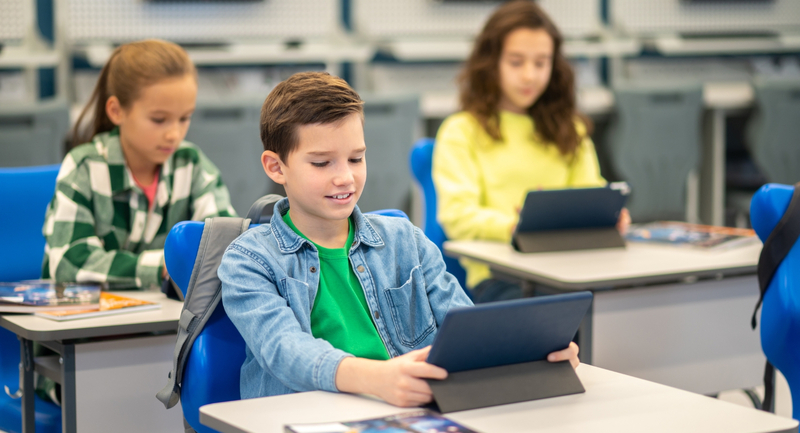In the uncertain early days of the pandemic, teachers faced a mountain of challenges communicating with families, even just trying to send a simple reminder or share praise. Full-on virtual learning may now be a thing of the past for many, but some strategies that educators used to reach students and families from a distance, especially tech-based ones, have proven useful even after the return to the classroom, according to a new study from the University of Chicago.
“The practices that we identified as promising, we believe, were received positively because they really catered to family’s needs,” said David Orta, a senior research analyst at the University of Chicago Consortium on School Research and a co-author of the study, in an interview with ASCD.
The researchers assembled six focus groups composed of either caretakers or educators and then looked for connection points between the two demographics to parse out universally successful communication strategies. The participants, 59 in total, all live in Chicago, and one focus group was conducted entirely in Spanish.
The lessons researchers identified include some school and district management adaptations, such as enlisting non-teaching staff members to serve as additional resources for parents, but most focused on utilizing technology to streamline educator-guardian interactions. Some of those approaches include:
- Providing virtual meeting options with more flexible scheduling opportunities for parents.
- Using mobile apps to strengthen timely communication between parents and educators.
- Adopting digital translation services to directly communicate with parents who speak languages other than English.
Tech-Supported Relationships
It’s not that these technologies—apps like Remind or Google Translate—are brand new, but the study participants praised the flexibility that they afforded educators and caretakers alike during distance learning. According to Orta, one teacher described a challenging moment during a midterm exam she was giving to students remotely. A student had their screen turned off and wasn’t responding to requests to turn on video during the exam, so she sent a message through Google Text directly to the student’s parent. Moments later, the student’s image popped up on the screen.
Sending a message through an app on a phone might not sound revolutionary, but for teachers trying to stay connected to their students’ guardians, it can be revelatory.
“That teacher really espoused the value that they saw in the use of the app, that it was sort of immediate,” said Orta. “The message was known to be received, it didn’t just fall into a black box, like an email might.”
The immediacy of sending a message and receiving an answer is also a benefit of meetings. Pandemic risks aside, asking family members to come to schools to meet with educators in person has presented deep-rooted barriers for some, the researchers found. As one parent in the study reflected, in Spanish:
When parents were the ones that needed to speak to a teacher, we were the ones that needed to go directly to the school either very, very early before classes started, or go very, very late when we picked our children up.
The flexibility of virtual meetings eliminates the time needed for caretakers to get to school and helps busy or working families keep in contact with teachers. Normalizing video meetings as a communication strategy beyond the end of the pandemic could be an important step toward breaking down those walls, the researchers found.
While investing in direct lines of communication is critical to building strong relationships with families of any students, it may be especially important for families of English learners, as Ari Gerzon-Kessler wrote in Educational Leadership in 2019. Parents and caretakers who don’t speak English have often encountered challenges forming connections with teachers because of language barriers, explained Orta.
To address this problem, districts across the country have increasingly tried to enlist administrators, community members, or even students who speak the languages of school families to serve as translators when teachers need to communicate with them. While this might work in a crunch, there are downsides to having an intermediary in teacher-family correspondence, said Orta.
“Something gets lost there in that dynamic when it becomes less of a direct relationship and communications get sort of watered down,” Orta explained.
Instead, many schools (like, for example, some in and around St. Louis) have adopted translation services or apps to give educators the chance to communicate directly and in real time with non-English-speaking families. These services support communication in Spanish, but also plenty of other languages, including Arabic, Somali, and Vietnamese and help parents and guardians feel centered in discussions about their children, Orta said.
Multi-Faceted Solutions
Ultimately, the report’s findings reflect an ongoing shift in education around the country: as educators, leaders, and students continue to transition through a seemingly endless procession of pandemic-related changes, they’re adapting to the often-digital tools that have helped establish a sense of stability. That’s a positive, reflects Orta, but he cautions that tech adaptations are just one piece of a multipart approach to school-family relationships. As he notes, tech inequities still divide families and learners in Chicago and everywhere else.
“The thing that we try to caution is that . . . when technology worked, it worked really well. But the consideration here is that not everyone always had access to the devices, to the same bandwidth, to the same skills, to familiarity with technology,” said Orta.
“We don’t necessarily want to suggest that it’s one-size-fits-all when it comes to this communication, but thinking about it strategically, as a schoolwide effort, and a community-building effort,” he continued.
Community building in particular is a concept the study’s participants valued. To add to Orta’s statement, when technology worked, it helped bring people together. As one parent reflected:
I think that when apps are used throughout the school, sharing what’s happening around campus through the app is good because it’s not just a few moms that find out stuff, but all parents do.








